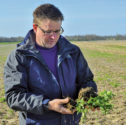Advertise Follow Us
Items Tagged with 'grid sampling'
ARTICLES
Randy and Dan Linville are making their sloped fields more productive by feeding the soil and seeding cereal rye to improve soil tilth and reduce erosion.
Read More
What I've Learned from No-Tilling
Weeding Out No-Till Challenges
North Carolina grower Jimmy Thomas uses a combination of no-till practices to tackle weeds, rocks and marginal soils.
Read More
Crop Diversity, Precision Technology Push No-Till Further
Seeing the potential for more than just erosion control, Ohio growers Bret and Gene Margraf overhauled their no-till system by adding wheat and cover crops, variable-rate seeding and fertility and split-nitrogen applications.
Read More
Emerging Tools For Evaluating Soils Could Change How You Farm
Improved electromagnetic sensors and on-the-go software yield 3-D maps of soil profiles that may help no-tillers fine-tune field management decisions.
Read More
9 Straight-Forward Ways To Boost No-Till’s Bottom Line
Soil testing, cover crops, tiling and a top-notch planter has helped no-tiller Jack Maloney hit corn yields topping 200 bushels.
Read More
No-Till Notes
New Technologies Knocking: Do You Answer?
Whether it’s narrow rows, better guidance systems or innovative equipment, no-tillers should make sure these new tools help them meet their goals.
Read More








